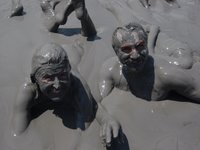Grenada

.JPG)
The Carrib settlement was quite something else, especially the church. The settlement is on the rugged north east coast and it has about 3,000 inhabitants trying to preserve their culture in the new world. Once aspect of their culture has been abandoned we’ve been told. Cannibalism. Although the subject wasn’t broached we hoped they truly had given it up because it was close to lunch time and our Indian friend was looking hungry. According to James A Michener, in his book ‘Caribbean’ these guys paddled around the Caribbean and fought other passive tribes into submission. They would eat the men and boys and keep the women for breeding food. Pretty fierce and bloodthirsty. Their church was quite unique. It was a blend of Christianity and Carrib culture. A huge painting with Jesus in the center pinned to the cross and flanked on both sides by pictures of half naked men and women washing by the river or paddling their canoes. The alter was a canoe set upon blocks. No depiction of the people eating process that would have been interesting. Try to incorporate that into a sermon. They make their living from fishing, boat repairs, farming and weaving of intricate baskets etc.
A delicious lunch outside the settlement at a cute Cliffside restaurant with a great view then onto the nation park and rainforest walk. The park is set in the mountains and houses an interesting botanical exhibition and local craft stores. Walking through the cool, dense forest was such a relief after the heat of the coast and confines of the anchorage. There was such a fresh, invigorating yet tranquil feeling being in the forest. We hiked for a couple of hours and ended up at the base of a waterfall where we jumped in the pool and cooled off before returning to the base.
On the trip home we were shown some of the facilities that Fidel Castro and his ‘terrible regime’ had erected for Grenada in the late 70’s during Maurice Bishop’s rule. Bishop had some great socialist dreams for Grenada but was quite the thug. He and half his cabinet were later executed during another coup. Anyway the Cubans built schools, a hospital, an airstrip, etc to try to aid Grenada after gaining it’s independence in 1974. Along the way the guide pointed out some little wooden houses that he called ‘Kickem Jenny’ He explained that these had survived the last major hurricane to hit Grenada. Now wait a minute we thought, Grenada was in the hurricane exclusion zone. Not so. Jenny devastated the island in the 50’s and, statistically, it gets hit every 50 years or so. With this new info, and the year being 2004, gave us a very uneasy feeling about leaving our boat there in August. Many people scoffed at our ‘superstitious’ feelings and proceeded to give us advice about which haul out would be best or, who would mind Adagio at anchor. Our uneasiness wasn’t quelled and we decided to go to Venezuela instead. July 15th we fled to Puerto La Cruz to a marina in Venezuela and in August, regrettably, this beautiful island was devastated by Hurricane Ivan. Of the hundreds of boats that remained there only a handful survived. Tim and Amber had hauled their boat in one of the dockyards and we were worried about the outcome. Incredibly theirs was one of only a couple of boats there that survived with minimal damage. Many acquaintance’s dreams were shattered as their boats were destroyed before their eyes.
Before leaving Grenada though, we had the opportunity to watch a Grenada vs. USA football game amongst thousands of brightly coloured, pot smoking, steel drum playing local supporters. The atmosphere was absolutely exhilarating. We had a ball. It was a world cup qualifying game which, sadly, Grenada lost 3-0. They played with such enthusiasm and blinding speed but were
.jpg) outclassed by a better trained and funded, USA team. I’m surprised the small contingent of USA supporters below us in the stands weren’t beaten up over their ‘USA No.1’ chantings while the Grenadian National anthem was being played. Some of very large Grenadian men were shouting at them to shut up but there was no major incident.
outclassed by a better trained and funded, USA team. I’m surprised the small contingent of USA supporters below us in the stands weren’t beaten up over their ‘USA No.1’ chantings while the Grenadian National anthem was being played. Some of very large Grenadian men were shouting at them to shut up but there was no major incident.The sail to Venezuela, 130nm to Porlamar, Isla Margarita, was fairly straightforward, slow and very rolly. We had a large following sea and light winds so we rolled for a day and a half. Bloody horrible, what I would have given for a multihull. Bob on Plain Sailing had one and kept coming on the radio saying ‘isn’t this a lovely sail’ wanted to smack him but he’s a great guy so I didn’t. Along the way we entertained the option of stopping at Los Testigos for a couple of days but decided against it. Not too sure about the pirating situation around the area and we were running out of time.


0 Comments:
Post a Comment
<< Home